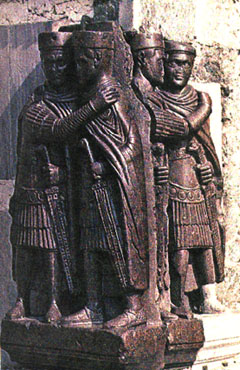 Contents -
Previous Article -
Next Article
Contents -
Previous Article -
Next Article
The Tetrarchy To deal with the instability the Roman Empire had experienced during the Third Century, Diocletian wisely decided that the empire was too large for one man to rule effectively. He would choose a co-emperor to help him to share the responsibilities of administering the empire. Also, if the two emperors made their capitals in different parts of the empire, they would be able to respond much more quickly to troubles that arose in their area. In A. D. 286, he chose Maximinus to govern the West as augustus while Diocletian would rule in the East. To ensure that the government would be passed along smoothly in case of the death of one of the augusti, each augustus appointed a caesar to be his replacement. In the meantime, the caesar would gain experience in governing. Thus the idea of the Tetrarchy, or rule by four men, was born. In 293, Diocletian chose Galerius as his caesar in the East and Maximianus chose Constantius I Chlorus as caesar in the West. All four of the men who made up the Tetrarchy were tough Illyrian soldiers like himself. Part of the reason the Tetrarchy worked so well is because these professional soldiers were intensely loyal to one another and especially to Diocletian. Another part of Diocletian’s plan was for the senior augusti to abdicate, or step down after twenty years of rule and allow the caesars to become the augusti in their place. The new augusti would then each choose caesars and thus keep the Tetrarchy complete. Diocletian believed that twenty years was long enough for any man to be on the throne. At the time of his and Maximian’s abdication in 305, Diocletian was in fact worn out and prone to sickness although his partner Maximianus wanted to continue to rule.
Go to next article:
Go back to previous article: